Rifles and cartridges: from Samuel Pauli to Edward Boxer
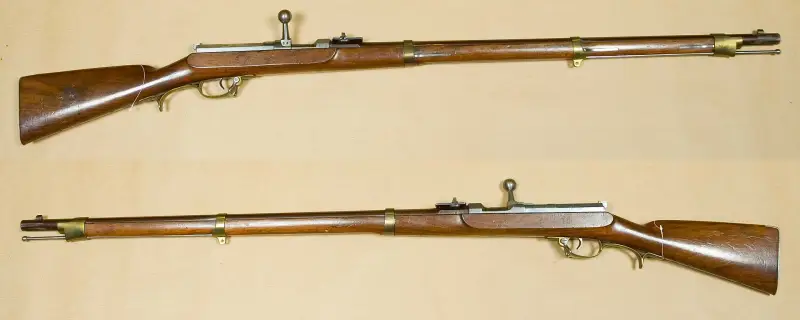
Dreyse rifle model 1841. Army Museum, Stockholm
(Don’t forget to wipe it!) -
Copper alloy cylinders,
At the bottom - explosive mercury.
Adam Lindsay Gordon (October 19, 1833 – June 24, 1870).
History rifles. It is clear that you cannot construct a rifle without having a suitable cartridge for this. It is also clear that the charging method weapon from the muzzle, pouring gunpowder into it and placing a bullet in it, we are unlikely to find an author known to mankind. His name, like the name of the inventor of the wheel, has long since sunk into oblivion. In this regard, the inventor of a capsule with a composition of mercury fulminate in a metal cap was much more fortunate. It is known that it was invented by the American D. Shaw in 1814.
However, the first unitary cartridge of the Swiss gunsmith Jean Samuel Pauli, which he developed together with the French gunsmith Francois Prelat, appeared a little earlier, and he also created the world's first cartridge gun of 15 mm caliber for it, a patent for which he received on September 29, 1812. In tests, it showed a rate of fire of 22 shots in two minutes and twice the range and accuracy of the then army guns. The Pauli cartridge consisted of a cardboard cylinder filled with an ignition initiator - berthollet salt (Pauli's main innovation), black powder and a round bullet. In the improved version of the cartridge, the sleeve was completely metal or cardboard-metal, and a capsule device was installed at the bottom. In fact, it was the prototype of the modern unitary central firing cartridge.
The new product was immediately reported to Napoleon, and he became interested in the innovation. However, the introduction of new weapons and their subsequent spread was prevented by the fall of the French Empire and the abdication of the emperor, and, generally speaking, it is unknown how the history of small arms would have developed in the future. Pauli himself, however, died in obscurity, and the fame of the creators of new weapons with new cartridges in Europe went to Casimir Lefauchet and Clément Potte...
However, before this happened, another important event occurred. The fact is that Johann Nikolaus Dreise, who studied to be a mechanic in the Thuringian city of Sömmerda and turned out to be capable of weapons making, worked in Pauli’s workshop. On April 5, 1814, Dreise left Pauli's workshop, who went to continue his work in London, and Dreise returned back to Germany. In England in 1817, Pauli created a gun design with a new for that time percussion mechanism with a combat spiral spring and a rod striker (later this design began to be used in almost all types of small arms), and it was this idea that Dreyse borrowed from him and used in his own gun. Pauli's new gun was loaded with all-metal cartridges turned on brass on a lathe, which guaranteed them considerable strength and the possibility of repeated use. In the bottom they had a hole for a capsule in the form of a modern children's cap, made of two circles of cardboard with a composition based on fulminate of mercury between them. The disadvantage of the cartridge was its high cost.
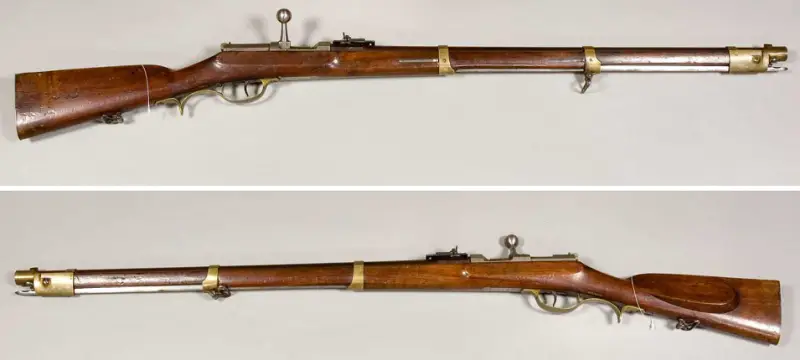
Jaeger rifle Dreyse model 1854. Army Museum, Stockholm
Therefore, Dreyse, familiar with Pauli's work, began by developing his own cheap cartridge, and already in 1827 he offered the Prussian military the world's first bolt-action rifle, which was adopted in 1840. The Dreyse cartridge looked like a paper cylinder, that is, it was cheap and familiar to the military. A drop-shaped lead bullet was held in it on a cardboard tray (spiegel) and did not come into contact with its rifling when moving along the barrel! The most interesting thing is that the shock-sensitive igniter primer was located precisely on this very pin, and not on the place we are used to - the bottom of the cartridge! To pierce the cartridge and get to the primer, Dreyse equipped his bolt with a long and sharp needle, which is why his rifle was called “needle”, and then this name spread to all other types of shotguns and pistols of a similar device.
During testing, the Dreyse rifle showed a rate of fire unattainable for percussion rifles of that time. In addition, a soldier armed with such a rifle could not be afraid of double or triple loading. However, she did not have a shutter. But due to the conical shape of the breech of the barrel, onto which the bolt slid, and the precise processing of the mating surfaces, gas breakthrough on it was excluded. There was also no need to have an extractor on the rifle - the remnants of the previous cartridge, if any remained in the barrel after the shot, were simply squeezed out of it by a new cartridge and bullet. In addition, since the bullet did not touch the walls of the barrel, lead plating of the barrel did not occur. And this was a serious drawback of all rifles of that time.
However, this gun also had shortcomings. So, it turned out that the bullet in the pan was often secured unevenly and flew out of the barrel, having a violation in the alignment. Therefore, the firing range of such a bullet was small, within 500 m. Another drawback was that the unburnt remains of the cartridge in the barrel interfered with the movement of the bullet, which again affected accuracy.
In addition, since the primer was on a tray, the needle that pierced the cartridge had to be very long. Being exposed to the combustion products of gunpowder, it quickly became unusable, and although each soldier had a spare needle, replacing one with another in battle was both troublesome and dangerous. Nevertheless, the Prussian army received both an infantry rifle, a Jaeger rifle (M1854) - shorter, and a rifle rifle (M1860) - also short and more convenient than an infantry rifle, and even a heavy fortress rifle designed by him with piston valve.
The rifle proved itself well in the battles of the Danish-Prussian and Austro-Prussian wars. During the Franco-Prussian War, the French needle rifle of Antoine Chassepot with a rubber shutter of a smaller caliber acquired the palm - 11 mm versus 15,43 mm, and with a higher bullet speed - 430 m versus 295 m. That is, it had greater flatness and rate of fire, although in accuracy it was inferior to the Dreyse rifle.
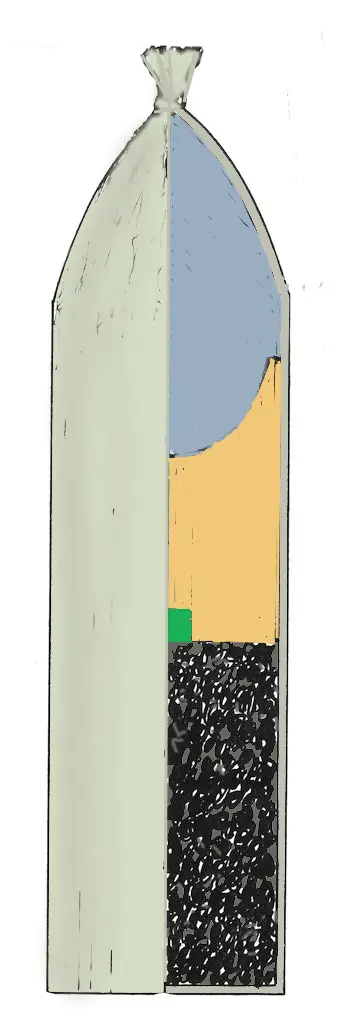
Dreyse cartridge in section. Drawing by A. Sheps

Chassepot cartridge in section. Drawing by A. Sheps
An interesting cartridge was developed in 1837 by the French gunsmith Casimir Lefauchet. It was a unitary cartridge with a metal sleeve, called a “hairpin” because of the firing pin protruding from the side of it. It was she who pierced the primer located inside the cartridge. However, due to the specificity of its design, this cartridge found use only in revolvers and hunting rifles - the military did not approve of it.
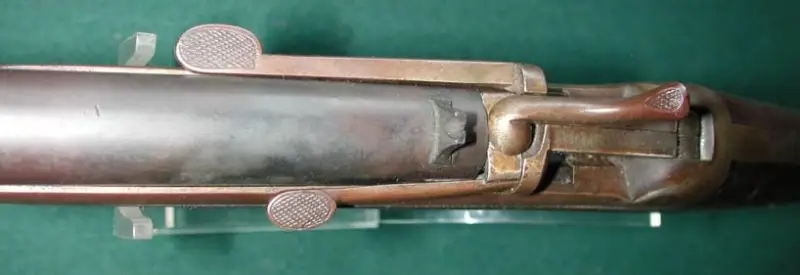
The breech of a Lefoshe hairpin carbine from 1859 with a trigger and two control levers at once: the one on the right raised the bolt up, and the one on the left pushed the spent cartridge case out of the chamber behind the pin. Photography by Allen Dobress
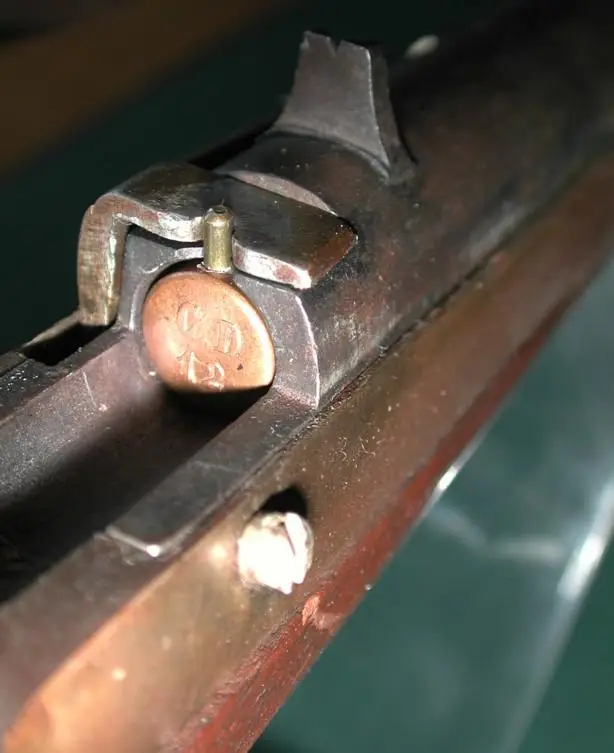
This photo clearly shows the main drawback of the Lefoshe cartridge: it could only be pulled out of the chamber by a pin - which on this carbine is pressed on by an L-shaped plate connected to a lever located on the left. Photography by Allen Dobress
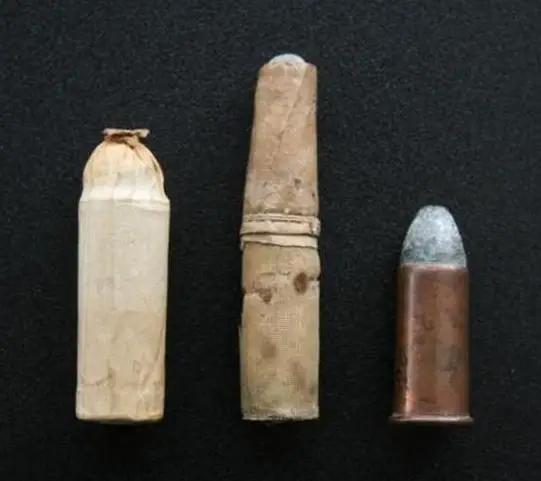
Appearance of cartridges (from left to right) Dreyze, paper Chassepot cartridge and metal Spencer rimfire cartridge. Photo from public Internet resource
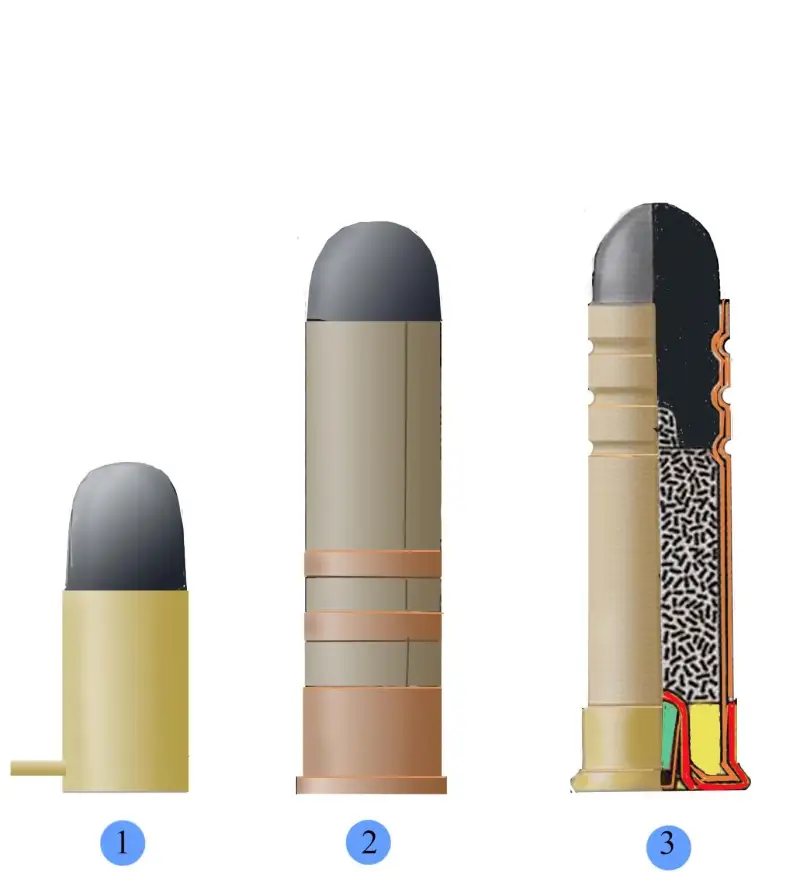
Lefoshe hairpin cartridge (1), cartridge for the Snyder rifle (first sample) with a brass bottom and paper sleeve (2), Potte cartridge (3). Drawing by A. Sheps
And then the same Dreyse and Chassepot rifles immediately became obsolete with the advent of central ignition cartridges from Potte (1855), Schneider (1861) and especially Edward Boxer (1864) with an all-metal brass sleeve and a long lead bullet wrapped in paper to prevent lead from the bore rifling trunk Clément Potte proposed a cartridge with a paper sleeve and a brass tray, on which there was a socket for the igniter primer, and his cartridges are still used in hunting weapons almost unchanged. Another significant event occurred in the USA in 1857: Americans Horace Smith and Daniel Baird Wesson created an all-metal unitary cartridge with a protruding rim and an initiating compound contained in it - the so-called rimfire cartridge! But in military affairs, the best cartridges turned out to be the Boxer design of 1864, which, thanks to their design, completely eliminated the breakthrough of powder gases through the bolt.

Chassepot rifle 1866/1873 Photography by Allen Dobress
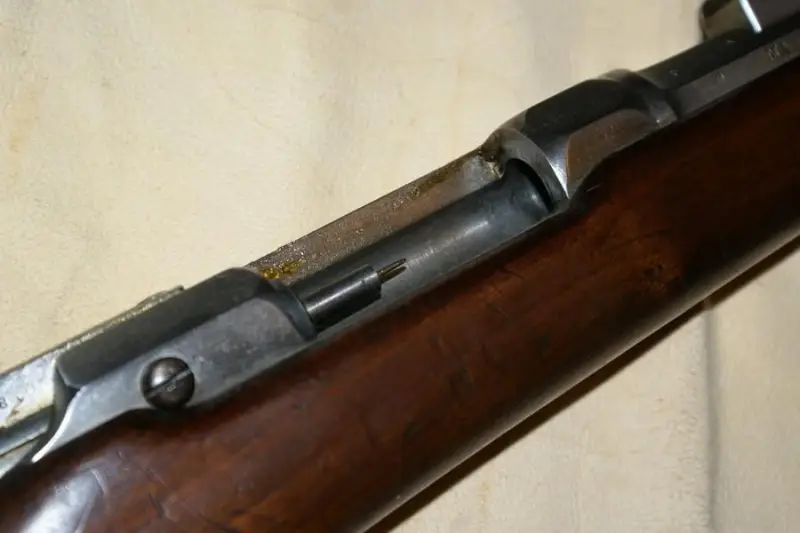
This photograph clearly shows the needle in the bolt of the 1866/1873 Chassepot rifle. Photography by Allen Dobress
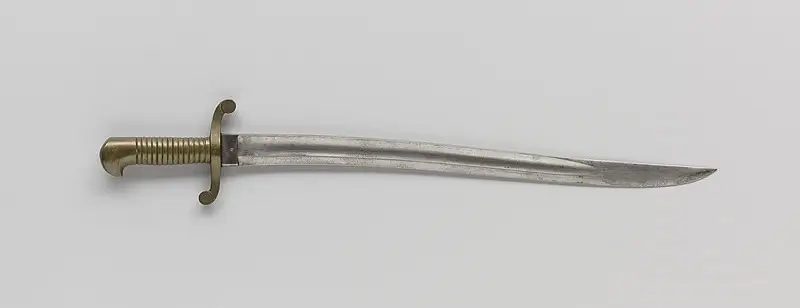
Scimitar bayonet for the Chasspo rifle 1862 Rijksmuseum, Amsterdam
The development of these two cartridges - with annular and then with central ignition - had a huge impact on all subsequent development of small arms. With the introduction of metal cartridges, not only the safety of handling weapons increased, but it turned out to be possible to establish their mass production. After all, before this, paper cartridges were glued by the soldiers themselves, which was a rather labor-intensive process. As a result, for example, almost every shot in the American Civil War was fired with a hand-made cartridge. However, now, thanks to the development of machine production technologies and the design features of all-metal cartridges, it has become possible to produce them on special pressing machines and use the same machines for their automatic loading.
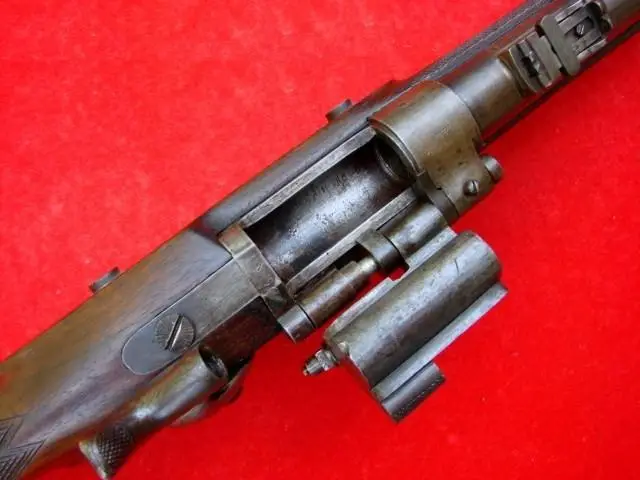
The bolt action, designed by Jacob Snyder, was designed for centerfire cartridges. It opened from left to right. It is interesting that the sleeve from the chamber in such bolts was pushed out beyond the rim by the bolt sliding back. But it was not removed from the receiver, and the shooter had to be shaken out or removed by hand! Photography by Allen Dobress
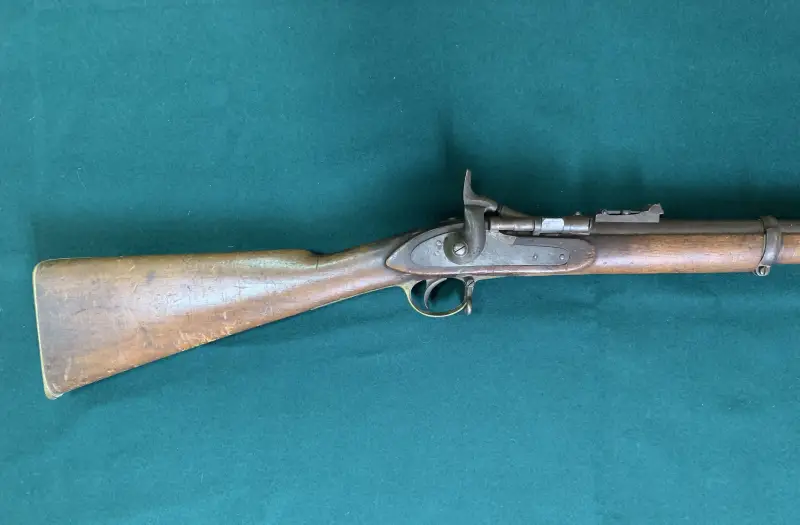
Model 1868 Snyder rifle. Weight: 3,8 kg. Caliber: 14,7 mm. Rate of fire: 10 rounds per minute. Bullet speed with black powder cartridge: 381 m/s. Effective firing range: 550 m. Maximum firing range: 1800 m. Penza Museum of Local Lore. Photo by the author
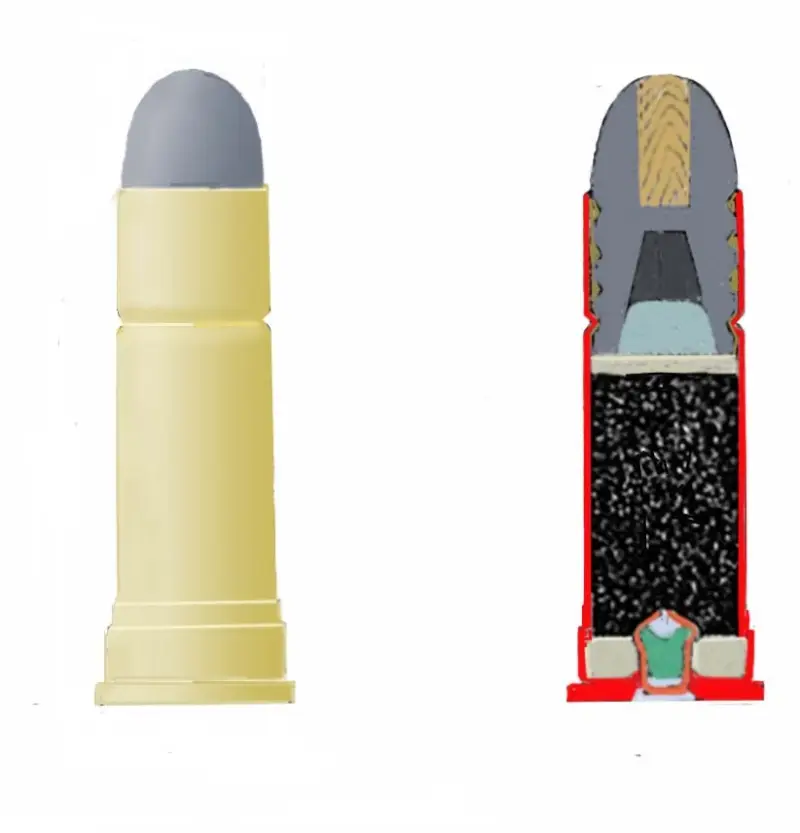
Edward Boxer cartridge for the Snyder rifle. Drawing by A. Sheps
In addition, metal-cased cartridges, along with improved mechanisms for extracting them, made it possible to reload much faster than before and paved the way for designers to create automatic weapons in the future. However, they still had a lot of work to do on this path...
Information